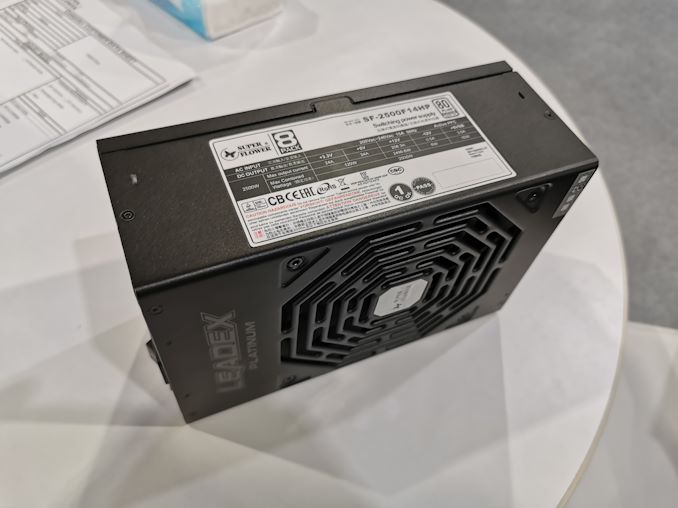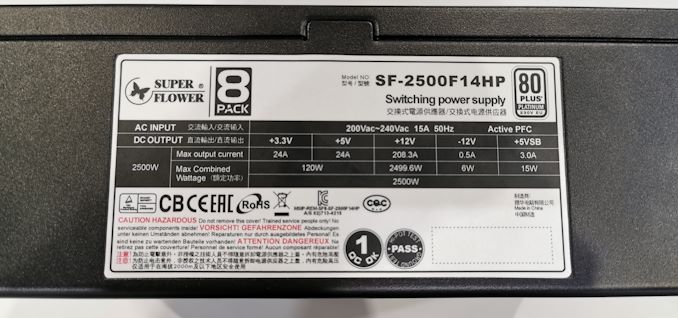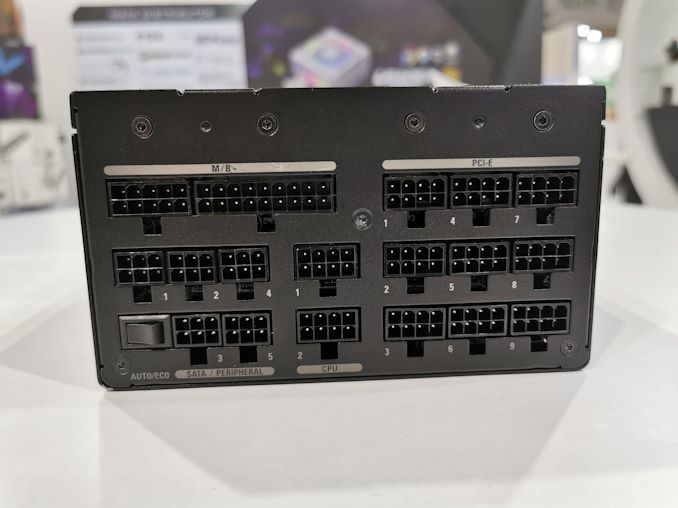Super Flower Shows 2500W Platinum PSU: It’s Not For You
by Ian Cutress on June 3, 2019 5:00 PM EST
Last year at Computex we did a round-up of some really crazy 3000W power supplies. These were essentially two PSUs in a single chassis, but the idea was to power multiple mining graphics cards. The quality of the units was questionable, and they didn’t adhere to any 80 PLUS specification. This year, we have a true high powered unit on show, however SuperFlower will not sell it to you.
The 2500W design is based on the company’s 2000W model, which is at retail, but with better binned components in order to keep the same rating efficiency. It’s large, and comes with a wide array of connectors. In order to achieve 2500W, the company is pushing 200+ amps through the main rail. Due to the power requirements, and the efficiency, this unit is only fit to work on 230V mains supply.
So why show it at all, if it’s not going to be on sale? The company representative told me that they wanted a unit that was the best of the best, to show off at events, but also the unit would be given to overclockers at a number of OEMs in order to help them try and break world records. In essence, they are giving these units away for free.
| Want to keep up to date with all of our Computex 2019 Coverage? | ||||||
 Laptops |
 Hardware |
 Chips |
||||
| Follow AnandTech's breaking news here! | ||||||


















24 Comments
View All Comments
azazel1024 - Tuesday, June 4, 2019 - link
No, they average 240v. It is alternating current. NA three-phase power is separated by 120 degrees true. However, what you see is voltage that alternates from a lot of 0v to a high of 170v for 120v. For 240v it is a low of 0v and a high of 340v. All alternating currents used (that I am aware of) are expressed as the root mean square. That means that over the course of the voltage sinewave it averages to the stated voltage.Some of the time the voltage is 0, sometimes it is 340v. It averages out to 240v.
It is split phase because it is delivered 120v on two conductors that are in phase, but have opposite voltage signs. So when one voltage is peaked at +170v, the other conductor has a -170v current on it. That is additive to a difference of 340v. The root mean square of the entire voltage sine wave between the two is a difference of 240v. If you connect only one of the conductors, you'd get a root mean square of only 120v.
The transformer outside of your house pulls power from only one of the three phases traveling on the conductors. What travels on the power lines, even residential is in the thousands of volts on each phase. It is stepped down to 240v split phase. In some commercial buildings and some special residential installations (IE REALLY big houses) it is delivered as full 3-phase power (still split, IE on two supply conductors and a neutral/return/ground conductor) at 240v. Industrial needs and what not get supplies in the thousands of volts with special installations where the supply voltage isn't stepped down (or isn't stepped down as far).
Typically you can get up to 360/400A delivered residentially (dual pedestal meter). 360A is sustained, 400A surge. Bigger residential installations will use this (my house has dual 200A service off the meter to two panels). I believe the maximum is a 6 pedestal meter (in the US) for larger commercial installations. You get 3-phase power from that and you are talking 864kw maximum delivered power (well, surge, I think the limit would still be 777,600 watts continuous).
I suspect if you also had that setup, you'd need unique power delivery from your utility company. But I imagine there are plenty of large commercial office buildings that use a large fraction of ~777kw.
akvadrako - Tuesday, June 4, 2019 - link
Time for the rest of the world to upgrade to 240V.azazel1024 - Tuesday, June 4, 2019 - link
Too expensive. Besides, the rest of the world does use 240v (much of the world uses 230v, which is slightly less efficient than 240v). It is just used only for high power draw equipment and some permanently installed equipment (for efficiency on the later).For instance my air handlers are on a 15a/240v circuit (don't make breakers of less than 15a. They draw about 2A@240v). My A/C compressors are on 20a/240v circuits (those draw I think around 10-12A@240v IIRC). My range/oven is on a 50A/240V circuit. Clothes dryer is 30A/240V. (oil water heater, or else an electric one would be on a 30A/240V circuit also). Well pump is on a 15A/240V circuit (draws about 2.5A@240v).
If you are going to upgrade, might as well just switch everything over to DC current while you are at it. Massively larger efficiencies to be gained from DC power generation, transmission, delivery and use than some stuff in your house using 120v.
I haven't done the math in awhile, but with typical conductor sizes in a US house you are wasting something like 3-5% of your power in heat dissipation in your wiring on average. That takes in to account high draw appliances like electric ovens, water heaters and driers that are pulling 20-40 amps at 240V. Most 120v stuff is generally fairly low draw and spread over multiple circuits. So the overall loss in wiring is relatively low.
You'd gain as much by switching to DC power use within the home (1 or 2%. Maybe) as you would switching everything to 240V within the home.
Now power delivery...you'd likely save 5-8% by switching to high voltage DC compared to alternating current.
Hul8 - Wednesday, June 5, 2019 - link
I just counted here:https://www.worldstandards.eu/electricity/plug-vol...
Exactly 17 countries are running 240V, 7 of which are small islands.
The dominant voltage used to be 220V. EU harmonized to 230V from the UK 240V and the 220V of the rest of Europe in 1995. Some countries have followed, some remain at 220V - China and Russia being the largest.